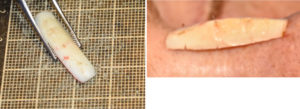Rib grafts are the material of choice for many larger augmentative rhinoplasties and complex nasal revisions. They offer a virtually unlimited amount of cartilage graft material that can be used anywhere on the nose from the bridge down to the tip and columella. Because cartilage is softer than bone and relatively easy to carve, it is a versatile graft material that can be shaped for a wide variety of nasal reconstructive needs.
Besides the need for a donor site, the other downside to a rib graft is that it is rarely completely straight. Much of the shape of the ribs is largely curved as it bends around the side of the chest to join into the sternum. When harvesting cartilage the surgeon tries to take the straightest piece possible but, more times than not, a sizable rib graft harvest is likely to have a bit of a curve to it. Thus some form of graft manipulation/reshaping is needed.
The most common form of rib graft reshaping is to carve it like one would a bar of soap. A scalpel is use to carve it into the desired graft shape. In doing so it is well recognized to be aware of the bend of the rib and the attachments of the perichondrium. Since the perichondrium exerts a pulling force on the surface of the rib, it is important to keep the perichondrium attached on the convex side away from the curve and to remove the perichondrium and cartilage on the concave side of the curve.

Dr. Barry Eppley
Indianapolis, Indiana


